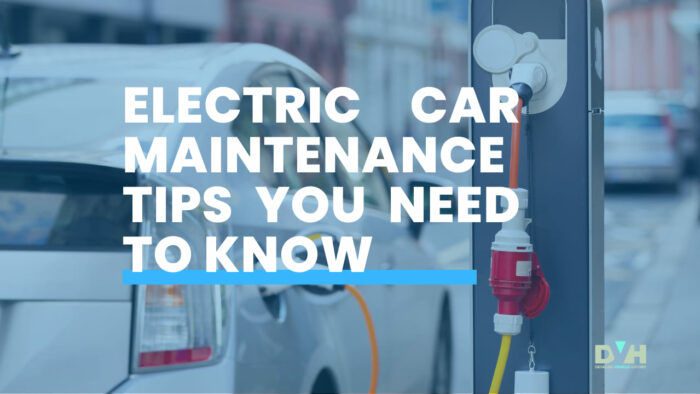As the need for clean energy sources and reduction in carbon emission spreads worldwide, the demand for electric vehicles has increased significantly. According to the Congressional Budget Office, the biggest source of carbon emissions in the US is the transportation sector. Although electric cars are more expensive than regular cars with ICE engines, they can significantly reduce the quantity of carbon emitted daily.
One benefit of purchasing an electric car is that the maintenance cost for electric cars is as low as $0.07 per mile, according to Sunnyvale Ford, and without proper maintenance, you may end up spending a lot more money than you may expect. In this article, we will be looking at the top electric car maintenance tips you need to know.
Electric Car Maintenance Tips: What You Need to Know
To prevent spending unnecessary money on repairs and replacements, it’s best to prevent the car from getting damaged or defective in the first place. To do this, you have to prioritize the maintenance of your vehicle. Although electric cars require less maintenance compared to vehicles with ICEs, there are still vehicle parts you need to pay attention to and keep in good shape at all times.
The tips to remember are:
Keep your battery charged
To keep your electric vehicle in the best shape, one of the most important things to remember is to always keep your battery charged. Regularly charging your battery helps to ensure that the battery stays in good shape for as long as possible. Charging your vehicle regularly also helps to prevent the battery from wearing out. Although electric car batteries are expected to last for 10 to 15 years, they may degrade faster if they are not properly maintained and charged.
To ensure that your battery is in optimal condition at all times, be sure to utilize a charging station whenever necessary. Also, you can invest in a portable charging cable to easily charge your EV while on the road.
Don’t overcharge or undercharge your battery
If you overcharge or undercharge your electric car’s battery for an extended period of time, it may cause it to degrade and wear out faster. Always try to keep your battery 20–80% charged at all times. If you plan on leaving your vehicle parked for an extended period of time, it is recommended that the battery should have at most 50% charge to prevent wearing out the battery cells.
Be mindful of extreme temperatures
Another thing to remember to keep your electric vehicle running for a long period of time is extreme temperatures. The ideal temperature for EVs is 21.5 °C (70 °F), and leaving your vehicle exposed to temperatures extremely higher or lower than this may reduce your battery’s lifespan and cause it to wear out sooner than expected.
Remember that the battery of an electric vehicle is worth between $5,000 and $20,000; keep this in mind when you carry out maintenance on your electric car.
Check your tire pressure
The next tip you should keep in the back of your mind after an electric car purchase is checking the tire pressure of your vehicle. Similar to every automobile, electric cars need the appropriate tire pressure to operate safely and efficiently. Be sure to keep an eye on your vehicle’s tire pressure and make sure that it is always within the manufacturer’s recommended range. If your vehicle’s tire is below the recommended pressure range, it may cause the tire to drag instead of rolling. This significantly increases the vehicle’s energy consumption, reduces the vehicle’s range, and also wears out the tires.
If your tires are above the recommended pressure range, you may end up with a vehicle that is extremely difficult to control on the road, as overinflated tires reduce a car’s handling.
Get regular tire rotations
While keeping an eye on your electric vehicle’s tire pressure, you should also be reminded that you need to get regular tire rotations to prevent wear and tear and achieve an even tread depth on all four tires.
It is recommended to have your tires rotated every 5,000 miles. However, refer to your manufacturer’s instructions to know the exact period to carry out tire rotations.
Check your brakes
Electric vehicles make use of regenerative braking, which means that the car’s motor generates electricity as the brakes are applied and transfers this energy to recharge the battery. This way, you get more range and reduce wear on the brake pads. According to Tesla CEO Elon Musk, an electric vehicle’s brakes may never need to be replaced as they require little or no maintenance. However, it is still recommended to regularly check your brakes to ensure they are in good shape and working fine. If you happen to hear any unusual sounds or vibrations when you apply the brakes to your vehicle, be sure to have it checked at an auto mechanic shop.
Inspect the fluids when necessary
Another electric car maintenance tip is regular inspection of electric vehicle fluids. If you want to keep your electric vehicle running as smoothly as possible, then you would need to regularly keep an eye on the fluid levels of your vehicle. If you use a hybrid vehicle with an internal combustion engine, you will need to make sure that the vehicle has sufficient oil at all times to keep the engine running smoothly.
If your vehicle also makes use of other fluids such as brake fluid, coolant, transmission fluid, thermal fluid, etc., it is best to check these fluids during your electric car maintenance and ensure that they are changed whenever necessary depending on the manufacturer’s instructions.
Keep your vehicle clean
electric vehicle’s efficiency. During maintenance of electric vehicles, it is recommended that dirt, grime, and other debris that have been deposited on the vehicle be completely removed to avoid damage to the vehicle’s paint, upholstery, and other car parts.
The upholstery, air conditioning, and ventilation systems are the most affected parts, and care must be taken to prevent defects. Regular washing and waxing can also help prevent damage to the vehicle’s exterior while vacuuming and wiping the interior can remove debris and dirt. Remember to make use of eco-friendly cleaning products and avoid harsh chemicals to avoid causing damage to your vehicle’s finish.
These are the most recommended tips for the maintenance of electric cars. Also, keeping an eye on the quantity of energy used by your vehicle can help you maximize its range and efficiency. This way, you can be mindful of your energy usage and adjust your driving habits accordingly. As with regular cars with ICEs, you will need to adjust your driving habits to get the most out of your electric vehicle.
ALSO READ: Hybrid vs Electric Cars: Pros & Cons and Which is Better?
Buying a used electric vehicle?
If you’re considering buying a used electric vehicle, it’s important to do your due diligence before making a purchase. One crucial step in the buying process is to conduct a VIN check on the vehicle and generate a vehicle history report.
The VIN, or vehicle identification number, is a unique code assigned to every vehicle that can provide valuable information about its history, including any accidents, repairs, or recalls. By running a VIN check, you can get a better understanding of the vehicle’s condition and ensure that you’re not buying an electric car with hidden problems. This simple step can save you from headaches and unexpected costs down the road, making it a smart investment in your used electric vehicle purchase.
With a VIN check from Detailed Vehicle History, you will be provided with a detailed vehicle history report having the following information on your electric vehicle:
- – Auction history with more than 10 photos
- – Sales history
- – Accident history
- – Vehicle Specifications
- – Damage history
- – Service records
- – Maintenance history
- – Lien and loan records
- – Theft records
- – Warranty information, and more.
READ ALSO: What Does Maintenance Required Mean?
Electric Vehicles: Dos and Don’ts
In summary, here are some dos and don’ts to get the most out of your electric vehicle and keep it healthy at all times.
DOS:
- – DO keep your battery charged: Remember, don’t overcharge or undercharge for extended periods.
- – DO check your range: The range of an EV depends on several factors, such as the temperature of the environment, terrain, and driving habits. Knowing these factors that affect your vehicle’s energy usage and reduce its range can help you improve its range.
- – DO maintain your car: Follow the manufacturer’s recommendations and maintain your vehicle regularly to keep it running smoothly.
- – DO use regenerative braking: Regenerative braking helps recharge the battery and reduces wear on brake pads. To get the most out of regenerative braking, decelerate gradually during stops and avoid slamming on the brakes.
DON’TS:
- – DON’T let your battery run low: It’s best to always ensure that your battery doesn’t run lower than 20%. Letting your battery run low may leave you stranded and lead to battery damage over time. No one wants to spend their life savings purchasing a new battery worth $5,000, so remember this tip.
- – DON’T use the heater or air conditioning unnecessarily: Using the heating and ventilation systems unnecessarily increases the electric vehicle’s energy consumption and reduces your vehicle’s range. Instead, dress properly for the weather.
- – DON’T ignore warning lights: Whenever a warning light pops up, don’t ignore it as it may be indicating a serious problem.
- – DON’T assume that all charging stations are the same: Some charging stations may offer faster charging times and be more reliable than others. Choose the best charging station you can access and use regularly.
As high-tech electric vehicles are gaining high popularity in the automobile industry, demand for these vehicles has significantly increased also. Electric vehicles are the perfect solution to the reduction of carbon emissions from the transportation industry and with proper maintenance these vehicles can have extended lifespans.









